Essential Drills to Master Basketball Dribbling
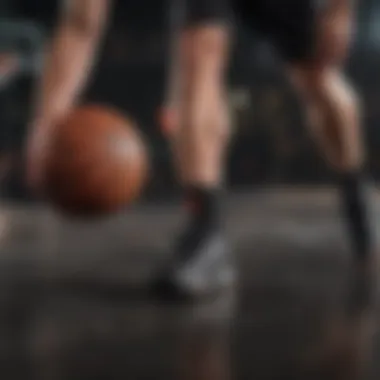

Intro
Dribbling is a fundamental skill in basketball that can significantly influence game outcomes. Whether you are a beginner grappling with basic movements or an advanced player refining intricate techniques, focused practice is essential. This article delves into various drills that can enhance your dribbling skills effectively. The drills discussed cater to different skill levels, ensuring that each player can find suitable ways to improve.
Techniques and Tips
Skill Development
Skill development in dribbling requires both practice and understanding. Players must learn to control the ball with precision while maintaining their speed. Key areas of focus include hand coordination, footwork, and body positioning. Each drill will play a part in honing these essential factors.
Practical Techniques
To kick-start improvement, here are some practical techniques players should incorporate:
- Crossover Dribble: This technique involves quickly moving the ball from one hand to another. Practice this with agility to create space between you and a defender.
- Behind-the-Back Dribble: Use this move to protect the ball from defenders. It builds not only skill but also confidence in tight spaces.
- Spin Move: A well-executed spin can be a game-changer. Focus on pivoting off one foot while protecting the ball with your body.
Repeatedly practicing these techniques will help integrate them into gameplay seamlessly.
Common Mistakes to Avoid
Players often make errors that hinder their progress. Here are some common pitfalls to watch out for:
- Over-dribbling: Keeping the ball exposed for too long can invite turnovers.
- Poor posture: Slouching can limit your mobility and reach during play.
- Neglecting peripheral vision: Always scan the court to see where your teammates and defenders are positioned.
By focusing on these aspects, players can greatly enhance their effectiveness on the court.
Gear and Equipment
Essential Gear for Beginners
For beginners, investing in the right gear is crucial. This includes:
- Quality basketball shoes for traction and support.
- A durable basketball suitable for indoor and outdoor use.
- Comfortable athletic wear that allows for freedom of movement.
Latest Innovations and Trends
Advancements in sports technology have introduced innovative products aimed at improving performance. Smart basketballs now track metrics such as dribbling speed and efficiency, giving players feedback on their performance.
Reviews and Comparisons
When choosing gear, consider looking at platforms like Wikipedia or Reddit for user reviews, which can guide your purchases.
Safety Measures
Essential Safety Gear
Safety should always be a priority on the court. Players should consider:
- Knee pads to protect the joints during fall.
- Mouthguards to prevent dental injuries.
- Ankle braces to support and stabilize the feet.
Best Practices for Safe Participation
Being aware of your surroundings and communicating with teammates can prevent many injuries. Always ensure that the playing area is clear of hazards.
Injury Prevention and Management
Maintaining a proper warm-up routine, focusing on flexibility, and listening to your body are key for injury prevention. If an injury occurs, expert advice is crucial for rehabilitation.
By embracing these practices, players can create a better and safer environment for themselves and others.
Finale
Mastering dribbling in basketball is not just about the drills; it is a holistic approach that includes understanding techniques, using the right gear, and maintaining safety. As players engage in these effective drills, they can expect not only to enhance their skills but also to elevate their overall game performance.
Prelims to Basketball Dribbling
Dribbling is a fundamental skill in basketball. It is the primary means by which players move the ball on the court, and it plays a vital role in both offense and defense. For any player—whether a novice or an experienced athlete—understanding the mechanics and importance of dribbling is crucial to enhancing their performance.
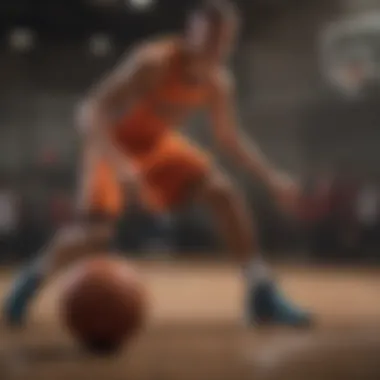
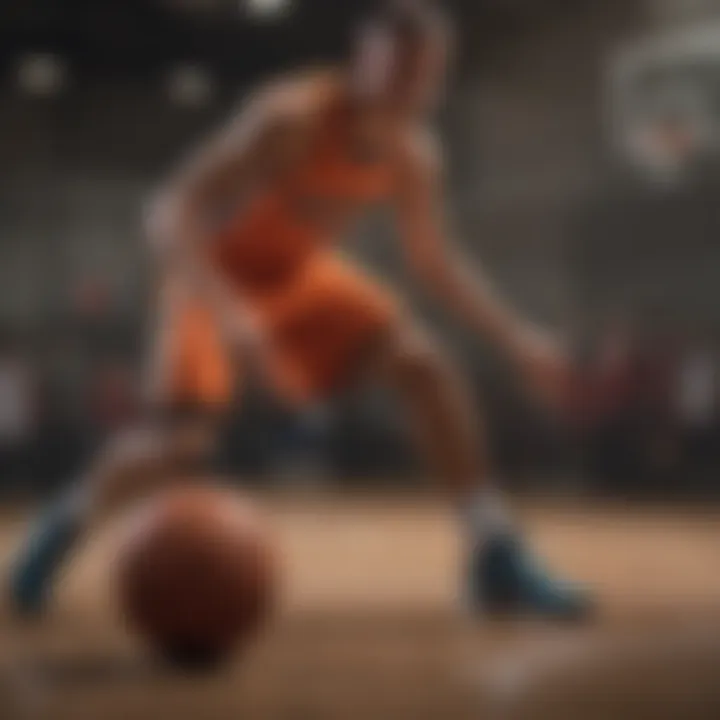
Importance of Dribbling Skills
Dribbling skills are essential for several reasons. Firstly, effective dribbling allows players to navigate through defenders, creating opportunities for themselves or their teammates. A player who can dribble well is not only a valuable asset on offense but can also evade pressure from the defense. Secondly, strong dribbling capabilities contribute to maintaining possession of the ball. Losing the ball during dribbling can lead to turnovers, affecting the player’s and team's overall performance.
Additionally, mastering dribbling techniques can improve a player's speed and agility. When players develop better control over the ball, they can execute plays with precision. Good dribbling also helps in building confidence which is vital during high-pressure games. Thus, investing time in sharpening dribbling skills pays off significantly.
Overview of Dribbling Techniques
Dribbling techniques can be diverse and tailored to various gameplay situations. Understanding the fundamentals and different styles can significantly impact a player’s effectiveness on the court. Some primary techniques include:
- Crossover Dribble: A deceptive move used to change direction swiftly.
- Behind the Back Dribble: This technique adds an element of finesse while protecting the ball from defenders.
- Spin Move: This helps in quickly changing direction and evading defenders.
Players should practice these techniques to find which ones suit their playing style best. Each technique serves a purpose and can be effective in different game situations, providing players flexibility in their gameplay.
An effective dribbler continuously evaluates their skills and incorporates various techniques to keep opponents guessing and off-balance. Learning these techniques requires practice and dedication, essential elements in mastering the art of basketball dribbling.
Basic Dribbling Drills
Basic dribbling drills are essential for building fundamental skills that every basketball player should possess. These drills focus on developing ball control, coordination, and confidence. For beginners, mastering these techniques can lead to better gameplay as they are the foundation for more complex maneuvers. Even experienced players can benefit from revisiting these drills to refine their skills.
Stationary Dribbling Techniques
Stationary dribbling techniques play a critical role in enhancing ball control. This practice allows players to focus solely on the mechanics of dribbling without the distraction of movement. At its core, stationary dribbling can include drills such as the "pound dribble," where players repeatedly push the ball hard against the floor, improving hand strength and touch. Practitioners should keep their knees slightly bent, maintaining an athletic stance.
Key benefits of stationary dribbling include:
- Improved hand-eye coordination
- Enhanced ball control in various situations
- Development of muscle memory for future dribbling maneuvers
To practice, players can start with their dominant hand and then switch to their non-dominant hand. Progression can involve alternating between hands to develop ambidexterity.
Crossover Dribble Drill
The crossover dribble is an effective move used to shift directions quickly while retaining ball control. This drill focuses on agility, quickness, and deceptive movements. Players should practice this drill in isolation, starting slowly and gradually increasing speed as they become more comfortable.
The proper technique involves planting one foot and quickly transferring the ball from one hand to the other. Players should ensure their head stays up to maintain court awareness. The crossover dribble not only helps in evading defenders but also enhances overall dribbling skills.
Consider practicing this drill both at a standstill and while in motion. This dual approach builds versatility and keeps defenders guessing during actual gameplay.
Figure Eight Dribbling
Figure eight dribbling utilizes spatial awareness alongside dribbling. Players should dribble the ball in a figure-eight formation around their legs. This drill enhances ball handling and improves hand coordination, especially when switching the ball from one hand to the other.
To execute this drill:
- Stand with feet shoulder-width apart.
- Start dribbling the ball with one hand, moving it around the opposite leg.
- Swipe the ball to the other hand and move it around the opposite leg.
As players become more comfortable, the speed of the figure eight can increase. This drill is excellent for reinforcing control and securing the ball in tight spaces.
Intermediate Dribbling Drills
Intermediate dribbling drills serve a critical purpose in the development of basketball players. At this stage, players have already mastered basic techniques. Now, they must refine their skills to enhance their agility and control during real game scenarios. These drills focus on improving footwork, hand-eye coordination, and the ability to maneuver effectively while dribbling. The benefits of intermediate drills extend beyond mere skill enhancement. They also bolster confidence and decision-making under pressure, which is essential when facing opponents on the court.
These drills require players to think strategically and react quickly, simulating the dynamic environment of a game. During practice, players must concentrate on both technique and execution. With consistent practice, they can integrate these skills into their gameplay, resulting in a more polished and competitive performance.
Cone Dribbling Exercises
Cone dribbling exercises are designed to improve agility and precision. To perform this drill, set up a series of cones in a straight line or zigzag pattern. The player will dribble the basketball in and out of the cones, focusing on tight control and maintaining a low center of gravity. This exercise emphasizes the importance of hand speed and dribbling technique. As players advance, they can increase their speed or adjust the spacing between the cones to increase difficulty.
Using both hands during the drill is essential. It develops ambidexterity and ensures that players are comfortable handling the ball with either hand. Such versatility is vital for breaking through defenses during a game.
Zigzag Dribbling Drill
The zigzag dribbling drill challenges players by integrating direction changes while dribbling. In this drill, players start at one corner of the court and dribble toward the opposite corner, making sharp turns at set intervals. Each turn should be smooth, and the player should maintain control of the basketball throughout the movement. This drill is critical for teaching players how to change directions quickly, which is often necessary in both offensive and defensive situations.
As players gain confidence, increasing the pace is beneficial. They can also practice with a defender, simulating game conditions so they can learn to navigate around opponents while maintaining control of the ball.
Change of Pace Dribbling


Change of pace dribbling is an advanced skill that focuses on a player's ability to vary their speed while handling the ball. This technique is essential for keeping defenders off balance. To practice, players can begin dribbling at a steady pace and then abruptly accelerate and decelerate at intervals. They might also incorporate fakes or hesitation moves to create space from a defender.
Experimenting with timing and rhythm during the drill is crucial. Players need to understand when to burst of speed and when to slow down. Mastering change of pace helps create openings for scoring opportunities and effectively maneuvering through defense.
"The ability to change pace is a skill that distinguishes great players from merely good ones."
Incorporating these intermediate drills into regular practice will significantly improve a player's dribbling skills. Success comes from consistent practice and a focus on developing each element intricately. Players should work diligently to integrate these drills into their training regimen, as this dedication ultimately translates into improved performance on the court.
Advanced Dribbling Drills
Advanced dribbling drills represent the apex of skill development in basketball. At this stage, players have already mastered the basics and intermediate drills. They require a higher level of agility, coordination, and control. The goal of these drills is to combine multiple dribbling techniques fluidly, allowing players to navigate through defenses more effectively. Such drills not only build confidence but also improve decision-making under pressure, which is crucial in actual game scenarios.
When players engage in advanced drills, they learn to utilize space, maintain ball control in tight situations, and exploit defensive weaknesses. These skills can elevate a player's overall performance and make them a formidable opponent on the court.
Through the Legs Dribble
The through the legs dribble is a vital skill for advanced players. It serves as both a protective maneuver and an evasive tactic against defenders. When executed effectively, this dribble can keep the ball away from a defender while maintaining speed and direction.
To perform this drill, start by dribbling the ball with one hand. As you approach a defender, push the ball through your legs to your opposite hand. This move requires precise timing and a low center of gravity to maintain balance. Here are some key points to consider:
- Make sure to keep your head up to gauge the defender's position.
- Engage your core for stability throughout the movement.
- Practice slowly at first, then gradually increase speed as you gain confidence.
This drill not only enhances ball-handling skills but also greatly contributes to an offensive player's arsenal.
Behind-the-Back Dribbling
The behind-the-back dribble is another impressive technique that can surprise opponents. It allows players to shift the ball swiftly without exposing it to defenders. This dribble is especially useful when a player is being closely guarded.
To execute the behind-the-back dribble, start with a strong dribble in one hand. With a quick motion, bring the ball behind your back to transfer it to your other hand. Pay attention to these tips:
- Ensure you dribble low to maintain control.
- Use your body as a shield between the defender and the ball.
- Integrate this move into game-like scenarios to build instinct.
Practicing behind-the-back dribbles can enhance reaction time and improve overall dexterity.
Dribble Relays
Dribble relays add a layer of competition to dribbling practice. This drill typically involves multiple players and can occur over various distances or obstacles. It encourages not only individual skill but also teamwork and anticipation.
To set up a relay, cones can be placed at intervals on the court. Players race in teams to dribble through the cones and back, focusing on control and speed. Consider these factors:
- Use a variety of dribbling techniques during the relay for versatility.
- Keep track of the time to encourage improvement.
- Emphasize the importance of communication with teammates.
Dribble relays foster a fun, competitive environment while players enhance their dribbling skills.
Advanced dribbling drills are essential for developing a player’s confidence and ability to maneuver effectively during a game. Mastering these techniques can significantly impact game performance and open up opportunities on the court.
Dribbling Under Pressure
In a basketball game, players often face defenders who apply relentless pressure. Mastering the skill of dribbling under pressure is vital for maintaining possession and creating opportunities. This facet of gameplay requires agility, mental fortitude, and a solid understanding of dribbling techniques. Players must develop confidence in their dribbling abilities, allowing them to navigate tight situations while minimizing turnovers. Practicing this skill enhances decision-making skills and boosts overall performance on the court.
Defensive Pressure Dribbling
Defensive pressure dribbling is the ability to control the ball effectively while opposing players are trying to steal it. This skill is essential. When defenders are near, a player must remain composed. The key elements to focus on include:
- Keeping the Body Low: Lowering the center of gravity helps in maintaining balance. A low stance allows for quick changes in direction, making it more difficult for defenders to anticipate movements.
- Using the Non-Dominant Hand: This technique is crucial. It allows players to shield the ball from defenders, making it harder for them to reach in and steal the ball.
- Eyes Up: Maintaining awareness of surroundings is very important. Players must scan the court to identify teammates and opportunities even under defensive pressure.
Drilling these techniques in practice scenarios can greatly enhance a player’s efficiency in real gameplay. Players can simulate defensive pressure by practicing one-on-one situations, focusing on maintaining control and making quick moves.
Dribbling with Limited Space
Dribbling in confined areas challenges the player’s ability to maneuver the ball effectively. This situation often occurs in crowded court areas, especially near the basket. To excel in these conditions, players should focus on:
- Tight Dribbling: Keeping the ball close to the body while dribbling maintains control and reduces the risk of turnovers.
- Quick Reflexes: Developing quick footwork will help in navigating through tight spaces. This can be practiced with drills that require players to weave through cones or defenders in a constrained area.
- Change of Direction: Being able to quickly switch directions can create separation from a defender. Players should practice abrupt shifts in speed and direction while dribbling.
Tips for Practical Application:
- Set up small areas on the court to practice dribbling under simulated game conditions.
- Work with a partner to create defensive challenges within these tight spaces.
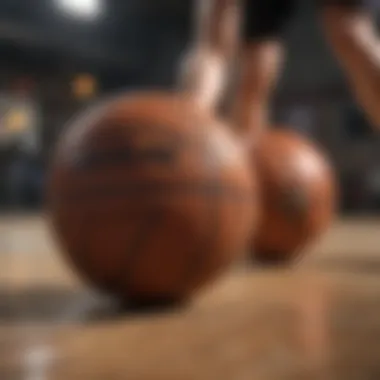
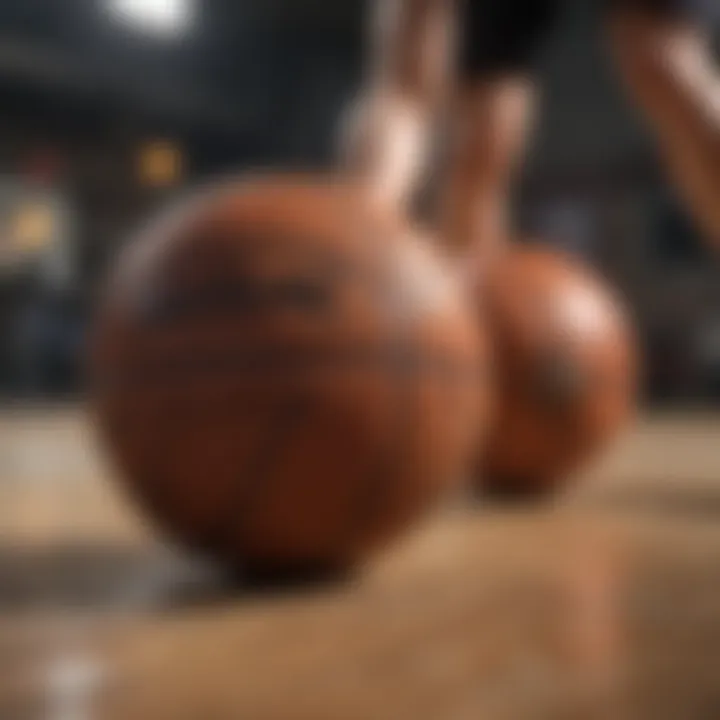
Through careful practice and dedicated focus on these components, players can enhance their dribbling abilities and become more effective under pressure.
Integrating Dribbling into Gameplay
Integrating dribbling into gameplay is essential for players seeking to enhance their on-court effectiveness. This aspect is not solely about practicing drills in isolation but understanding how to translate those skills into real-game situations. Effective dribbling can open scoring opportunities, create space, and maintain possession against defenders. Players must recognize the value of fluid transitions between defensive strategies and offensive plays. Understanding defensive formations can aid in determining when to utilize specific dribbling techniques, such as changes of pace, hesitation moves, or even through-the-legs dribbles.
When players master integration, they become more versatile. They can adjust their style based on the game flow. This adaptability contributes to overall team dynamics. It also boosts player confidence. An integrated approach demands awareness both of the ball and other players on the court, facilitating better gameplay decisions.
Transition Dribbling Techniques
Transition dribbling is a key skill, particularly in fast-paced situations or after gaining possession during a turnover. This phase of the game often requires speed and control at a moment's notice. There are specific techniques that players can employ to maximize their effectiveness in these scenarios.
- Push Dribble: This involves pushing the ball ahead while running. It is effective during fast breaks and quick transitions, allowing the player to cover distance while maintaining control.
- Long Dribble: Engaging in a long dribble helps cover ground quickly. This technique should be paired with sprinting to not only accelerate but also to fend off defenders.
- Speed Dribble: This combines a measured dribble with sprinting. Players learn to maintain control while maximizing their speed for optimal transitions.
Mastery of these techniques improves a player's ability to navigate the court efficiently. Recognizing when to transition and adapting to defensive responses is crucial for maintaining offensive momentum.
Dribbling in Half-Court Situations
Dribbling in half-court situations contrasts significantly with transition scenarios. In a half-court setup, the rhythm of the game slows. Players must focus more on precision, spacing, and strategic movement. Effective dribbling in this context involves understanding how to create opportunities through movement rather than speed.
- Isolation Dribbles: These allow players to capitalize on mismatches. It is essential to establish space from defenders. This can facilitate effective scoring attempts or passes.
- Pick and Roll: Here, players utilize teammates strategically. After setting a screen, the ball-handler must decide swiftly whether to drive, shoot, or pass based on defensive reactions.
- Creating Space: Players can use various dribble moves, such as crossovers or hesitations, to shift defenders away and create shot opportunities.
In half-court play, the player with the ball must maintain a clear vision of court dynamics. Understanding where teammates are located as well as possible defensive threats helps in making educated decisions.
Successful integration of dribbling skills into gameplay leads to coherent offensive strategies and enhances overall team performance.
Assessment and Improvement
The process of assessment and improvement is crucial for any basketball player aiming to enhance their dribbling skills. Continuously evaluating one’s performance can lead to insights and targeted adjustments that foster growth. For players, understanding their current skill level provides a baseline from which to measure progress. This practice is not merely academic; it offers tangible benefits that directly translate to better performance on the court.
Why Assessment Matters:
Assessment allows players to identify strengths and weaknesses in their dribbling techniques. By recognizing areas that require more focus, athletes can utilize their training time more effectively. Furthermore, regular evaluation helps in maintaining motivation. As players observe their own improvements, they gain encouragement to keep practicing and refining their skills.
Considerations for Improvement:
While assessment is about identifying gaps, improvement focuses on actionable strategies. Players should not just dwell on what went wrong but create a plan that emphasizes skill enhancement. Setting benchmarks during drills and tracking performance over time fosters a growth mindset. This can lead to significant advancements in agility and control.
"The only way to improve is to continuously assess where you are and where you want to be."
Self-Evaluation Techniques
To efficiently assess dribbling skills, players should engage in self-evaluation techniques. These techniques help in objectively analyzing one's gameplay and practice sessions. Some effective self-evaluation methods include:
- Video Analysis: Recording practice sessions allows players to watch themselves in action. This visual feedback can reveal flaws in technique that may not be apparent during live play.
- Drill Performance Review: Keeping a log of daily drills and noting performance can highlight trends. Players should note completion times, control levels, and number of successful attempts per drill.
- Peer Feedback: Playing with teammates provides an opportunity for constructive criticism. Watching others can also yield new insights into one’s own game.
These techniques are not one-time exercises. They should be incorporated into regular practice routines to ensure consistent improvement over time.
Setting Personal Dribbling Goals
Once players have assessed their dribbling skills, setting personal dribbling goals is the next logical step. Goals provide direction and motivate players to improve.
Strategies for Setting Goals:
When establishing goals, players should follow the SMART criteria:
- Specific: Goals should be clear. Instead of saying, "I want to improve my dribbling," a more specific goal would be, "I want to master the crossover dribble."
- Measurable: Define metrics for success. For example, achieve a certain number of successful crossovers in a row without losing control.
- Achievable: Set realistic goals based on current skill levels. Aiming too high can lead to frustration.
- Relevant: Ensure goals align with overall basketball objectives. Dribbling skills should complement other aspects of gameplay.
- Time-Bound: Set deadlines for achieving goals. This provides a framework for regular assessment of progress.
By putting these strategies into practice, players can systematically improve their dribbling techniques. Regularly reassessing these goals will also help in adapting to new challenges as they progress in their skill level.
Epilogue
The conclusion serves as a vital component of this article, emphasizing the significance of honing basketball dribbling skills. Throughout this exploration, we identified that proficient dribbling is not just about ball control; it directly influences a player's performance on the court. Dribbling drills are essential for developing agility, precision, and confidence, which all contribute to a player's overall game.
Recap of Key Drills and Techniques
To summarize the critical drills discussed:
- Stationary Dribbling Techniques focus on basic control and hand-eye coordination.
- Crossover Dribble Drill enhances the ability to change direction effectively.
- Figure Eight Dribbling builds agility and the skill to maneuver in tight spaces.
- Cone Dribbling Exercises improve dribbling accuracy while navigating obstacles.
- Zigzag Dribbling Drill simulates game situations and improves lateral movement.
- Change of Pace Dribbling teaches players to keep defenders guessing.
- Through the Legs Dribble and Behind-the-Back Dribbling add flair while keeping the ball secure.
- Defensive Pressure Dribbling and drills under limited space emphasize real-game scenarios, fostering adaptability.
- Transition and Half-Court Techniques integrate dribbling into actual gameplay contexts, solidifying the skills learned.
Each of these drills supports the enhancement of overall dribbling skills and prepares players for competitive environments.
Encouragement for Continuous Practice
Commitment to regular practice is crucial for improvement. Mastery of dribbling techniques does not happen overnight. It requires consistent effort. Players should dedicate time each week to refine their skills. Creating a structured practice schedule can help maintain motivation and track progress.
Incorporating these drills into various practice sessions ensures a well-rounded skill set. As players advance, they should challenge themselves with more complex variations and competitive scenarios. This ongoing practice not only fosters muscle memory but also builds confidence on the court, allowing players to apply what they learn during games effectively.
Ultimately, the journey of improving dribbling skills is continuous. By committing to daily practice and reviewing key techniques, players can significantly enhance their game performance and stand out on the court.
Remember, consistent practice is key. Stay focused on your goals, and the results will come.





